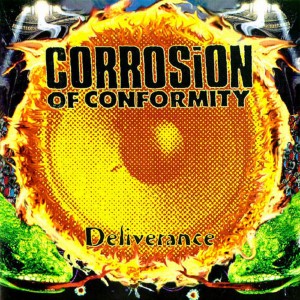I am happy to welcome Ryan to our team of crack writers. Ryan is a friend of mine that I was introduced to for the first time over a game of Talisman. Yes, we were still friends after that so it says a lot about our relationship. We are excited to show you his new segment, A Bard’s Eye View, which will be covering what I like to think are some interesting topics in the genre of music. Enjoy!
In music, while it is often preferred that a band present new and exciting sounds on each and every album, there is usually a desire for a band to keep their signature style and sound that fans have come to love. It is not uncommon for a band to try out a new sound and to experiment. Sometimes they get accused of “selling out” (In Flames has a decisively more “simplistic” and “radio-friendly” sound than the days where they helped establish melodic death metal as a subgenre back in the mid-1990s) and can often alienate their fans. Today, I’m going to explore some of the more drastic changes in sound and pinpoint the exact album in which that change occurred. I will look into some of the contributing factors of that change and try to decide whether or not it’s a strategy that benefited them.

KATATONIA (SWEDEN) – DISCOURAGED ONES (1998)
Dan Swanö experienced a similar issue as Jonas Renkse when he was performing in Edge of Sanity. He found that harsh vocals were very difficult to maintain over prolonged periods of time (especially when touring extensively). Jonas found himself unable to perform harsh vocals. For one album and one EP, Mikael Åkerfeldt (Opeth, ex-Bloodbath) lent his vocals while Renkse continued to drum for the band in hopes they could preserve the death/doom sound they had become known to play.
Unfortunately, strictly hiring session musicians limited their chances to have successful live performances as the session musicians were typically unavailable due to their other obligations. It was Swanö who suggested that Renkse try clean vocals. This led to a decision that forever changed the sound of Katatonia. The doom elements remained throughout the rest of their discography but any semblance of death metal has since been removed as their sounds have slowly evolved into a more gothic, alternative, and (sometimes) electronic sound.
For me, there will always be a special place in my heart for the older Katatonia (though not as strongly as I love the 2003 Viva Emptiness album—the one that introduced me to Katatonia) sound, but I feel like the direction they took, though sudden, was a completely logical one to take.
OPETH (SWEDEN) – HERITAGE (2011)
Opeth has always been a band redefining their sound while always being distinctly Opeth. Their first three albums was a blend of progressive black metal and progressive death metal while being produced by Candlelight Records, the following three were progressive death metal with progressive rock elements. In 2003, Damnation was released (initially intended to be released as a double album with Deliverance), a strictly progressive rock album. Ordinarily, I would pick that album as it has no harsh vocals or any real heavy guitar to it but Damnation at the time was considered an experiment and an exception to their typical sound. This much was evident when Ghost Reveries was released in 2005 and their return to the progressive death metal sound returned.
In 2011, Heritage was released and again featured the only clean vocals that Damnation had, but the album evoked a completely different feel. Whereas Damnation was very keyboard heavy and almost depressing in nature (which, when the mood strikes, is excellent), Heritage has more of a straight rock n’ roll sound, giving a nod to some of the bands in the 1970s. I wasn’t sure if this album was going to be another exception (“Damnation 2”, some people called it) but Pale Communion released in 2014 continued on this new sound.
It’ll be interesting to see how Opeth will continue to evolve from here, the days of heavy metal seem to be fairly well behind them, but Mikael Åkerfeldt has always prided himself in his ability to make whatever type of music he wants. I’m always on board for whatever changes may come from him, as they are creative and ambitious.
PORCUPINE TREE (ENGLAND) – IN ABSENTIA (2002)
Porcupine Tree may never getting back together, a friend and I discussed this a little bit at length when we saw singer Steven Wilson and his solo band perform back in June of 2015. We came to this conclusion based on the fact that a couple Porcupine Tree songs were included in the setlist when none had been previously performed when we saw him.
That being said, Porcupine Tree has always had a significant impact on my musical preferences. I first heard the song “Wedding Nails” on one of those cable TV stations that just plays music and I was completely impressed with what I had heard. I did not know the full scope of what I would be getting into when I purchased this record as a precocious 17-year-old. While the album is undeniably progressive rock as all of its predecessors had been, there was a significant change in sound from the previous album, Lightbulb Sun (released in 2000). Where Lightbulb Sun had been a poignant and satirical jibe at conventional pop songs, In Absentia was heavily inspired by Steven Wilson’s experience with hearing heavy metal bands and working with Opeth on the Blackwater Park album.
The evidence is clear in the composition of the songs on the album. Porcupine Tree had gone through previous albums with a psychedelic and experimental feel. The albums following continued in the same vein and the very same could be said about Wilson’s solo work.
BATHORY (SWEDEN) – HAMMERHEART (1990)
Bathory experimented with some Viking metal in Blood Fire Death two years prior, but Hammerheart is widely considered the first Viking metal album. Already helping pioneer black metal in the early 1980s, Quorothon found the genre no longer fulfilling and decided to take the process in a new direction. Where songs had previously been 2-4 minutes in length,
Hammerheart features an average of nearly eight minutes per song. Consequently, the lyrical content of the album is significantly different as it focuses on Viking lore as opposed to the anti-Christian themes featured in the previous four releases.
Bathory went on to record various other albums, mostly sticking to the Viking metal subgenre, but also experimenting with different subgenres throughout their discography. This album was not only pivotal in changing their direction but also in defining a new sound entirely unexplored in the past.
CORROSION OF CONFORMITY (UNITED STATES) – DELIVERANCE (1993)
With Karl Agell in the band in the previous release in 1991, Corrosion of Conformity wasalready beginning the move into their stoner rock sound (sludge in this case), but still incorporated much of the crossover thrash with the punk influence they had had in the 1980s. With Pepper Keenan on vocal duties, the music changed considerably. The music discarded its thrash sound and adopted a Southern rock and stoner rock sound that it has maintained to present day.
In addition to the sound of the instruments and composition changing, Pepper Keenan has quite possibly one of the most distinctive voices in music. His deep vocals and Mississippi accent lends a very noticeable difference over Simon Bob and Agell’s previous sound.
There were quite a few honorable mentions, and perhaps another time I will explore them. These were the first ones to really stick out to me and I’m happy to share them with you. Feel free to take the time to listen to the albums and compare it to that of their previous albums.




